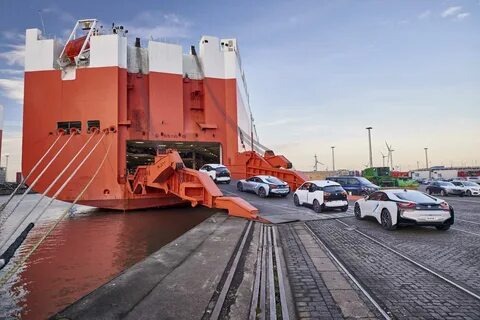The Steel Guardians of Global Car Shipping
Imagine your prized vehicle embarking on an international journey, cocooned in a climate-controlled steel vault as it crosses oceans and continents. This is the reality of modern car shipping through shipping containers – a system so reliable it moves millions of vehicles annually while protecting them from harsh weather, prying eyes, and road hazards. Those ubiquitous steel boxes you see stacked at ports and on trains have become the unsung heroes of vehicle logistics, offering protection that open transport simply can’t match.
A Revolution in Vehicle Protection
The standardization of shipping containers in the 1950s unexpectedly created the perfect solution for safe vehicle transport. What began as a method for shipping dry goods transformed into the gold standard for moving cars internationally. Today’s vehicle containers are far more sophisticated than their ancestors, featuring advanced tie-down systems, climate control options, and security measures that make them ideal for everything from daily drivers to million-dollar collectibles.
The magic lies in their simplicity: standardized 20-foot and 40-foot steel boxes that can seamlessly transfer between ships, trains, and trucks without ever exposing their precious cargo to the elements. This intermodal capability means your vehicle can travel from a dealership in Germany to your driveway in Texas without ever being exposed to rain, sun, or road salt along the way.
Engineering Marvels Designed for Cars
Modern shipping containers used for vehicles are technological marvels disguised as simple steel boxes. The best units feature corten steel walls that resist corrosion from saltwater, marine-grade flooring that won’t warp or retain moisture, and precision ventilation systems that prevent condensation buildup during temperature changes.
Specialized variants take vehicle protection to another level. Refrigerated containers maintain perfect climates for sensitive classics, while hard-top containers allow crane loading for non-operational vehicles. High-cube containers provide extra headroom for SUVs and lifted trucks, and some premium units even feature internal monitoring systems that track temperature, humidity, and security during transit.
The Art and Science of Container Loading
Watching professionals load a vehicle into a shipping container reveals a ballet of precision engineering. Every movement is calculated – from the exact angle of the ramps to prevent scraping, to the millimeter-perfect positioning that maximizes space utilization. The loading process varies by vehicle type:
Classic cars often receive special treatment with soft straps that won’t damage paint, while modern SUVs might be secured with wheel nets and chassis braces. Professional handlers know exactly how much tension to apply – enough to keep the vehicle rock-steady during ocean crossings, but not so much as to stress suspension components.
Climate preparations are equally meticulous. Desiccant packs combat humidity, fuel stabilizers preserve gasoline during long voyages, and battery disconnections prevent drainage. For international shipments, undercarriage steam cleaning is often required to prevent cross-border soil transfer.
Around the World in Climate-Controlled Comfort
Tracking a container’s journey reveals the incredible efficiency of global logistics. A vehicle might begin its voyage loaded into a container at a specialized depot, then travel by truck to a rail yard, transfer to a train bound for the coast, and finally be lifted by massive cranes onto a container ship – all without ever being exposed to the elements.
At sea, the container becomes one unit among thousands stacked like Lego blocks on modern cargo vessels. Advanced stabilization systems keep these floating cities steady even in rough seas. Upon reaching the destination country, the process reverses until the container arrives at its final delivery point – with the vehicle inside as pristine as when it began its journey.
Unmatched Security Features
The security advantages of container shipping are unparalleled in vehicle transport. Steel construction provides a physical barrier far more formidable than fabric covers or open trailers. Modern containers boast:
High-security locking mechanisms that resist tampering
Numbered seal systems that show evidence of any unauthorized access
Optional GPS tracking providing real-time location updates
Some premium services offer smart containers with internal sensors monitoring for light, motion, or temperature changes
For ultra-high-value vehicles, additional measures like bonded storage at ports or armed security escorts can be arranged. The container essentially becomes a mobile vault, protecting contents during transit and while waiting at ports or rail yards.
Why Containers Outperform Open Transport
While open car carriers dominate domestic routes, containers offer distinct advantages for discerning shippers:
Complete protection from weather extremes – no sun damage, road salt, or hail exposure
Elimination of road debris impacts during transit
Prevention of prying eyes and potential theft opportunities
Ability to ship multiple vehicles in a single container (when using specialized racks)
Climate control options for sensitive vehicles
More stable handling during ocean crossings compared to roll-on/roll-off ships
For classic car owners or those shipping high-value modern vehicles, these benefits often justify the premium over open transport methods.
The Green Choice for Eco-Conscious Shippers
Surprisingly, container shipping represents one of the most environmentally responsible ways to move vehicles globally. Modern container ships are marvels of efficiency, moving vehicles with far lower carbon emissions per mile than individual transport. The ability to stack containers makes extremely efficient use of space, while advanced routing software minimizes fuel consumption.
When comparing the carbon footprint of driving a vehicle internationally versus container shipping, the container often comes out ahead – especially when moving multiple vehicles in a single unit. Steel containers themselves are sustainability champions, typically being reused hundreds of times before eventual recycling.
Emerging Technologies in Container Shipping
The future of containerized vehicle transport looks brighter than ever with several exciting developments:
Smart containers with real-time condition monitoring and alerts
Automated loading systems using AI for perfect vehicle positioning
Advanced materials making containers lighter yet more durable
Blockchain technology streamlining international documentation
EV-specific containers with charging capabilities during transit
These innovations promise to make container shipping even more secure, efficient, and tailored to specific vehicle needs in coming years.
Choosing the Right Container Solution
Selecting the ideal container service depends on several factors:
Vehicle value and condition determine whether standard or premium options are appropriate
Destination requirements vary by country (some mandate specific cleaning procedures)
Timeline considerations (standard shipping vs expedited options)
Special needs like climate control or extra security features
Understanding these variables helps match each vehicle with the perfect container solution for its journey.
The Ultimate Protection for Precious Cargo
In an era where vehicles represent both significant financial investments and personal passions, shipping containers offer peace of mind that open transport simply can’t match. Whether moving a family car overseas or shipping a rare collectible across continents, container transport provides an unmatched combination of security, climate protection, and handling expertise.
Next time you see those stacks of shipping containers at a port or on a train, remember – inside those unassuming steel boxes are countless vehicles traveling safely to their next adventure, protected from the elements and handled with care every mile of their journey. For discerning vehicle owners, container shipping remains the gold standard in automotive logistics.


